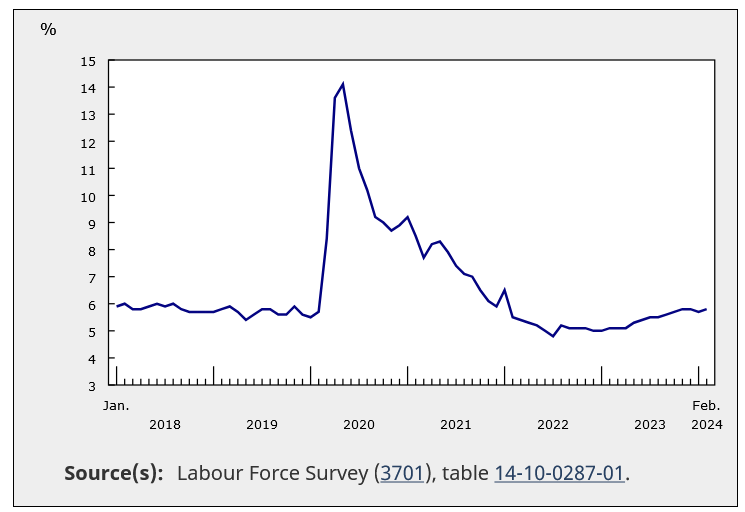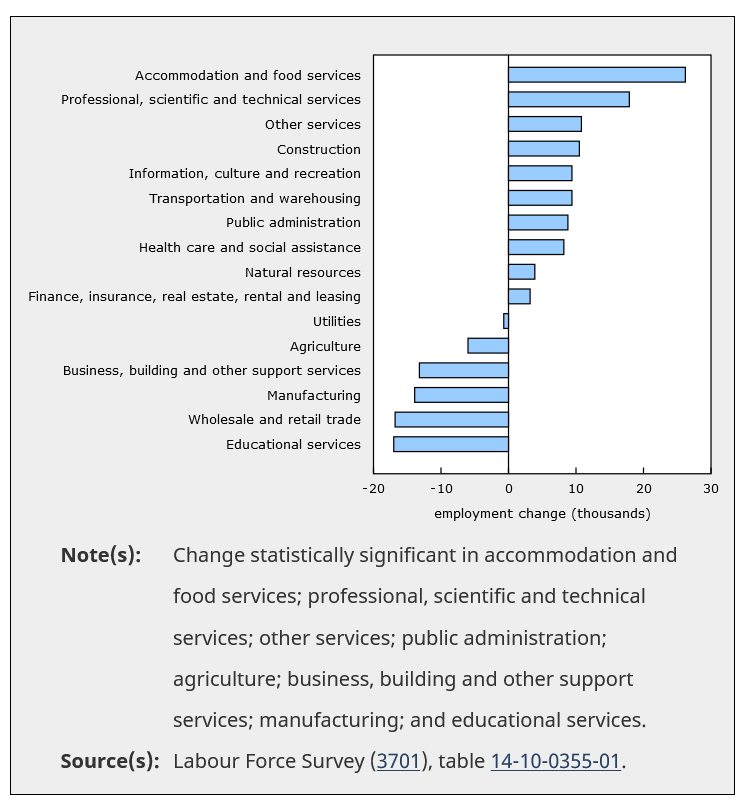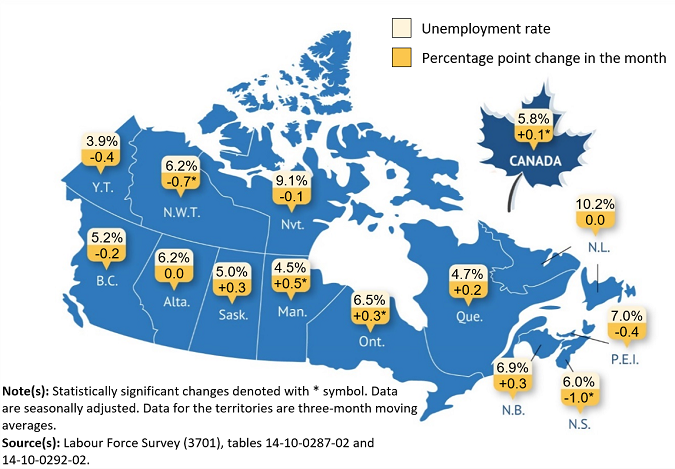
But unemployment rate hits 5.8 per cent: StatCan

In February, Canada saw a notable uptick in employment, adding 41,000 jobs, a 0.2% increase, building on a similar trend from January, which recorded an increase of 37,000 jobs.
This positive momentum was predominantly driven by a surge in full-time work, with a noteworthy addition of 71,000 full-time jobs, marking a 0.4% gain, says Statistics Canada.
The Canadian job numbers remained “remarkably consistent” in February, according to Indeed senior economist Brendon Bernard.
“Employment posted gains that historically would’ve been considered quite solid, but in the context of Canada’s soaring population, weren’t enough to keep the unemployment rate from ticking up. Nonetheless, the 5.8% jobless rate still suggests the labour market continues to hold on amid the current period of economic uncertainty.”
On a year-over-year basis, full-time employment exhibited steady growth, rising by 260,000 jobs (1.6%), while part-time work increased by 108,000 jobs (3.0%).
However, the employment rate saw a marginal decline of 0.1 percentage points, settling at 61.5% in February. This marked the fifth consecutive monthly decline, highlighting the challenges posed by rapid population growth, which has outpaced employment gains over the past year, says Ottawa.
The current rate stands 0.9 percentage points lower than the recent peak observed in February 2023 at 62.4%.
Demographic employment patterns
Core-aged women (25 to 54 years old) experienced a positive shift in February, with employment rising by 45,000 jobs (0.7%). This marked the first rise since September 2023. In contrast, core-aged men saw a modest uptick of 23,000 jobs (0.3%).
The employment rate for core-aged women rose by 0.3 percentage points, reaching 81.4% in February 2024, as employment growth outpaced population growth. Core-aged men maintained a steady employment rate at 87.2%, according to Statistics Canada.

Over the past year (February 2023 to February 2024), both core-aged men and women saw a downward trend in employment rates, declining by 0.9 percentage points for men and 0.5 percentage points for women. However, both groups continue to outperform their respective 2017-19 averages (86.5% for men and 79.3% for women).
Employment rates for young individuals (aged 15 to 24) remained largely unchanged in February 2024. On a year-over-year basis, both young women and men saw declines in employment rates by 4.6 and 2.3 percentage points, respectively, says Ottawa.
However, challenges surfaced for women aged 55 and older, as employment declined by 29,000 jobs (1.4%), accompanied by a 0.4 percentage point drop in the employment rate to 30.1%. Employment for older men remained stable, but their employment rate decreased by 0.2 percentage points to 40.2% in February.
Unemployment rates in February
The unemployment rate saw a modest increase of 0.1 percentage points, reaching 5.8% in February, offsetting the decline recorded in January. This follows a period of relative stability in recent months, with the rate holding at 5.8% for three of the past four months. The labor force participation rate remained steady at 65.3% in February, according to the Labour Force Survey.

Among core-aged men, the unemployment rate rose by 0.2 percentage points to 5.3%, reflecting increased job-seeking activities. In contrast, core-aged women experienced a decline of 0.4 percentage points to 4.6%, offsetting the increase observed in January.
Young men aged 15 to 24 faced a notable rise in the unemployment rate, increasing by 1.0 percentage points to 12.0%, while young women experienced marginal change at 11.1%. On a year-over-year basis, both young men and women witnessed an increase in their unemployment rates.
Employment insights by sector, province
Employment gains were observed in several services-producing industries in February. Accommodation and food services saw growth of 26,000 jobs (2.4%), rebounding from a decline in January. Professional, scientific, and technical services experienced an increase of 18,000 jobs (0.9%), offsetting the decline in January, says StatCan.
Notable growth was also observed in "other services" (including personal and repair services) with an addition of 11,000 jobs (1.4%), along with public administration, which grew by 9,000 jobs (0.7%).

However, the education services sector witnessed a decline of 17,000 jobs (1.1%), partially offsetting the increase observed in January. Employment also decreased in manufacturing (-14,000; -0.8%), business, building, and other support services (-13,000; -1.9%), and agriculture (-6,000; -2.6%) in February, says Ottawa.
In February, Alberta saw a notable increase in employment, adding 17,000 jobs (0.7%), continuing the upward trend since September 2023. Nova Scotia also experienced growth, with an increase of 6,300 jobs (1.2%). Conversely, Manitoba faced a decline of 5,300 jobs (-0.7%), and Ontario's employment held steady, with little overall change since June 2023. Quebec showed little employment change for the fifth consecutive month, with the unemployment rate holding steady at 4.7%.